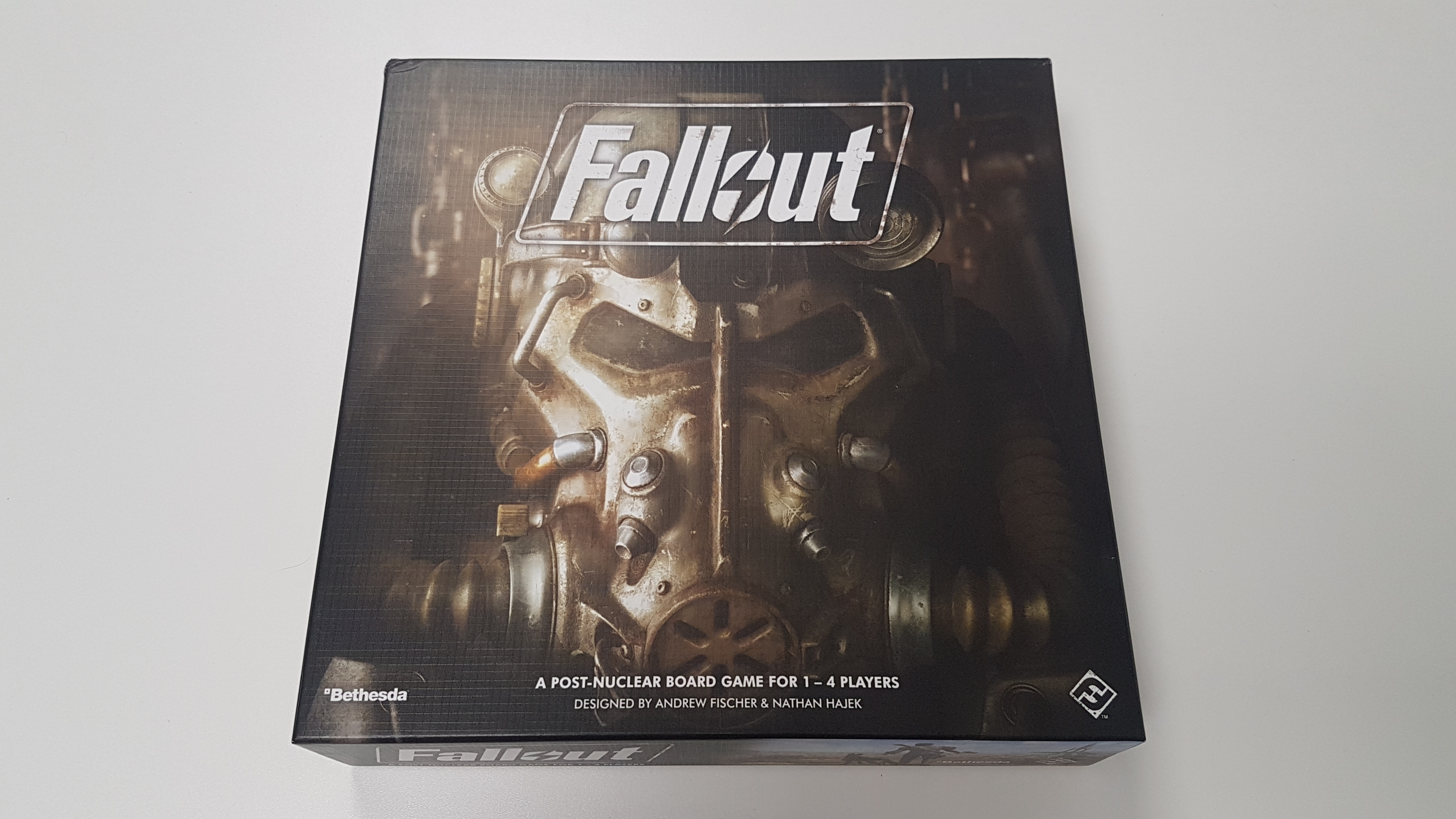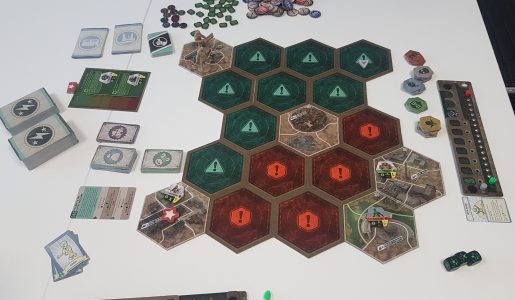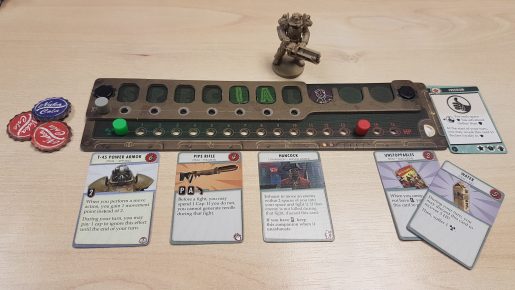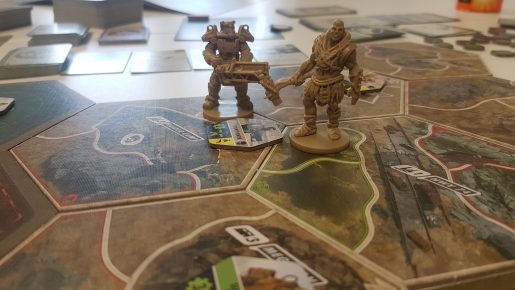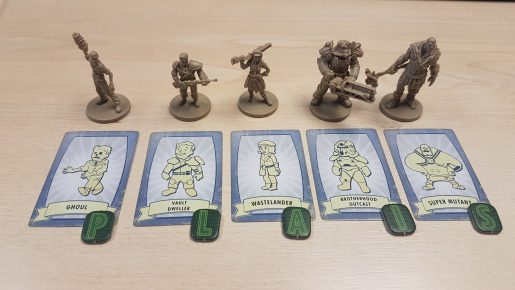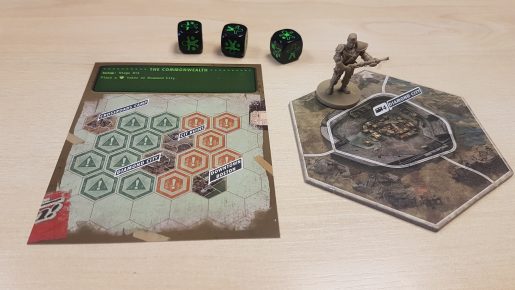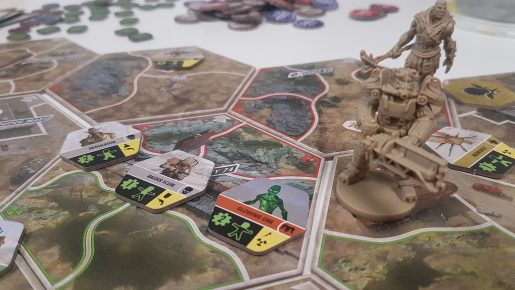Fallout is a video game franchise known and loved by many. However, at the very end of 2017 the series made its first jump into the medium of board games, offering a thematic post-nuclear experience for 1 – 4 players. From Fantasy Flight Games, the board game is played out through scenarios, across a mostly unexplored modular board. Prominent locations from Fallout 3 and Fallout 4 appear along the way, including Megaton through to the Far Harbour expansion of the latest video game. With different classes to play, enemies to avoid or defeat, hand management and VATs is this an experience worthy of the iconic franchise? Let’s find out!
To start with setup does take a little while but this is because you are setting up an adventure to experience. After choosing a scenario card, players follow the starting information to generate the hexagon-based map, with specific tiles face up in predetermined places often showing iconic locations from the video games. Starting quest information is revealed and markers for these may need to be added onto the board. Players then choose from the five available characters, from a non-feral ghoul to a super mutant, with some humans in the middle.
Each character starts with a specific SPECIAL token. Whilst being abstracted from the way the system is used in the video games, these are effectively your “special” stats that can help with a variety of tasks, providing re-rolls. Each character also comes with something different about them, for example the super mutant gets the super mutant trait, which can affect the options available in quests, whilst the wastelander starts with a slightly less dramatic tire iron. On top of this players get to grab an additional, but different, starting SPECIAL token randomly from the central pool. Finally, each player gets a secret Influence card, which not only gives an influence point it also gives each player at least one way for them to gain another point.
After some sorting of the encounter decks, the shop and making sure everything else is in reach, it is time start the adventure. From here the outcome is left up to players, allowing them to: follow quests, explore the mostly face-down map, kill an endless stream of enemies; all to gain the influence needed to win before either of the in-play factions claim victory. On a turn a player gets 2 action points to spend, and they can do any action, in any order, including repeating anything other than encounters.
The most common action is move, which gives the player two movement points to be spent at any time on their turn, together or individually. There are some restrictions such as moving onto difficult terrain costs 2 movement points but normally it’ll see the player moving across spaces on the face-up hexagons. To gain access to those face-down tiles, a must for any game progression, someone must use an explore action while adjacent to a facedown tile. This flips it and sees the new tile become accessible, and any relevant enemy spawn.
As the enemies close in it’ll be time to fight. Some units will initiate combat by just entering the same space as them while others you’ll have to spend an action to enter combat. Each enemy has a level and where on the VATs dice you need to roll to deal damage. The level represents the number of hits, via the dice, you’ll need; plus 1 if they have a shield symbol. After rolling the dice, a player might have an item and the SPECIAL stats needed that allows them to helpfully reroll. Once the final dice roll has concluded players determine if they have killed the unit or not. From the same dice roll it is also determined if they take damage. Certain sides of the dice feature stars, which are what go into the damage calculation: the amount of health lost equals the stars rolled minus your armour value, multiplied by the units level. For example, 3 stars rolled, while wearing a 1 defence item, from a level 2 enemy equals 4 damage taken [(3-1)*2]. Fear not, this calculation becomes very quick and easy to do when playing.
Utilizing a combined radiation and health meter system, similar to the health stamina system in Dark Souls The Board Game, whenever a player takes damage the move their red health peg one step down, starting at 16. If radiation is ever taken the green peg is moved up, with it starting at 0. If the two cross at any point the player dies and after losing any items not being worn they respawn on the starting tile with full health but with the same radiation level as before. To limit the amount death occurs, players can choose to spend an action to camp, to regain 3HP and temporarily gain the well-rested trait that grants a reroll.
Encounters take place at a variety of indicated places across the wasteland. These are split out into three types: Wasteland, Settlement and Vault decks. Getting to one of these locations will see another player drawing the top encounter card for you and reading the flavour text and options. From the options the player can decide what to do, perform any checks by rolling the dice, and then the outcome is revealed. Some of these can be relatively non-eventful, leading to shopping at a vendor, while others can see enemies spawn and attack or see new quests added into the encounter deck forming a sort of side quest.
Either via killing an enemy or quests, players will gradually gain XP. Along the top of the player boards is a grey peg that moves from hole to hole under each letter you have of SPECIAL. Once at the final letter and you gain more XP it is time to level up. Taking two special tokens from the central pool the player chooses one to keep and one to return to the pool. If it is a letter the player didn’t previously have it is simply added to their player board, adding another letter of XP needed to gain future levels. If the player chooses a letter they already have the token is returned to the pool and a perk of matching attribute is gained by the player. These are strong one time use abilities such as Gun Nut which can be discarded at a Settlement to gain a weapon from the shop or discard pile.
Once everyone has had a turn of spending two actions the board gets a turn. This sees some enemy units move towards the player characters by one space or attack if in range when activated. One thing that can be bad for players, early on, is that enemies can move across unexplored, face-down, tiles – only costing them one movement. This can see the enemies charging players down if they don’t spam explore. What enemies activate is determined by the influence deck, the same cards that give players influence points. Each has symbols on the bottom, which aren’t used by the players otherwise, that dictate which enemies activate that round.
Without going into detail on specific quests, or quest lines, players will find most will have more than one way to complete it, often advancing one factions grip on the area. Depending on which players choose to do different quests will be unlocked, locking others away for future playthroughs. Quests can range from getting to a location and paying for information through to killing off a glowing feral ghoul. Some of these, like the location-based objectives, require a player to spend an action to complete them. On top of new quests; loot, experience points and even new influence cards can be up for grabs. This makes going for quests very important for hitting the influence goal first.
As the game progresses players will accumulate influence from their cards and secret influence objectives. When one person has reached the goal of 11 influence when solo, 10 influence for 2 players, 9 for 3 players or 8 when at maximum player count, they win. Conversely if no one manages this after either faction has made it to the end of the faction tracker everyone loses the game together, the factions have just too much control.
Just like in the video game players will get their hands on a variety of items, from looting dead enemies to the more civil approach of purchasing something from a vendor. Equipment can be key to surviving combat, but it can also help to have some bottle caps saved up for quests, therefore there is a bit of a trade-off. Drawing from the video games players will find comics, be able to obtain more powerful weapons and even become addicted to drugs… One notable difference in the drugs department is that rad away is an extremely rare commodity. This makes choosing to take radiation damage via movement a tough decision, though the Lead Belly perk card can cancel all radiation out in one go.
The respawning of enemies is done in a very video game way, some like this and some get frustrated by what is an endless wave of opponents. Whenever you defeat an enemy its token is removed from the board, with a new token of matching type being added inactivate to the closest spawn point of that type. While this does eleviate the issue of remembering where it came from, this does occasionally see players standing on top of spawn points essentially spawn killing the various enemies. It would also have been nice to see a difference whether a player initiates combat, or an aggressive enemy chooses to fight. Either way the enemies always attack first, perhaps some kind of advantage based upon whom was the initiator of the combat could have been added in.
The components of Fallout are simply top quality. The player boards that are two think cardboard pieces solidly fixed together, using the standard Fantasy Flight connectors, give a robust board with indentations for the special tokens. The 5 included miniatures are well sculptured, though it does make you long slightly for more including a Mr Handy robot or a Deathclaw, to make the enemies units of the game also pop from the board. The map players traverse is made from chunky hexagon tiles, giving the modularity for players to explore from one game to the next. Most of the tiles are in the easy or hard hexagon sets but some are double-sided tiles to flick between the Fallout 3 and 4 settings. Overall, the components combine to make a game that should last plenty of visits to the table.
I must admit I was hesitant replaying one of the scenarios, however all players around the table (almost like a hive mind) had independently decided to charge down the major quest route that had been missed the time before. This showed how from only a few quest changes and randoming the more generic wasteland tiles can drastically change the way the game plays out. All of a sudden, locations which were hard to reach due to a bank of difficult terrain were not only easier to get to, but a highway was in the ideal place making it even less distance to travel. This combination allows there to be variation from the offset and almost rewards players for exploration, an aspect that is sometimes painfully missing from board games.
Each time I’ve played I have been drawn into the Fallout themed narrative, from the main quest lines to the smaller side quests that pop up along the way from encounters. For all their brilliance there is a discontinuity in the “side-quests” that are added into the encounter decks. Despite the game being competitive it is possible for one player to trigger a quest to be added into the encounter deck, in lore getting the quest item, only for a different player not present at the original event to finish the follow-up encounter. This would make much more sense in a cooperative game where it would make sense for companions to share information and quests.
Being a game from Fantasy Flight it is hard not to expect some sort of expansion and I truly hope that there is more content on the way. At times it felt storyline aside like the quests would arbitrarily move a faction on the tracker for the influence mechanics. Being cooperative and being able to discuss how you’d want to advance the story would just have a nicer feel to it and generate communal stories of “we did this” rather than it being forced by another players actions. I hope that an expansion is more cooperative focused, but either way additional scenarios and starting quests would be an incredible way to keep this board game fresh!
For all of the feeling of a lacklustre ending to some games, where the factions have won, I still keep getting drawn back to Fallout. As with the video games, the destination isn’t what the experience is about; instead it is the journey you take and what you find and discover along the way that will keep gamers returning for more. There are turns which are uneventful, often seeing double movement being taken, but if the player count is low then it’ll soon be back to your turn. For me, a fan of the franchise the board game captures the choose your own path and adventure feel the video games have given me, with some great details being brought across. It has also managed to engage players whom have never encountered the post-nuclear wonder that is Fallout. Thankfully, doubts of replayability issues have been subdued but expansions will be needed to keep the game fresh for a long time.
[Editor’s Note: Fallout was provided to us by Fantasy Flight Games for review purposes.]

